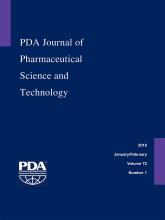Abstract
Use of prefilled syringes to self-administer biologics via subcutaneous administration provides convenience to patients. The barrel interior of prefilled syringes is typically coated with silicone oil for lubrication to aid plunger movement at the time of administration. This study intended to evaluate the impact of formulation variables on the silicone oil on the barrel interior surface. Characterization techniques including syringe glide force, break loose force, Schlieren imaging, contact angle, inductively coupled plasma spectrometry, and thin film interference reflectometry were used in assessing the interactions. Data indicated that formulation variables such as pH, buffer/tonicity agent type and concentration, and surfactant present in the formulation can effect silicone oil lubrication of prefilled syringes, leading to changes in functional properties of the syringe over time. Syringe samples containing acetate and histidine buffers showed an increase in glide force at accelerated storage temperature conditions, but the change was minimal at 5 °C. The samples with the highest glide force correlated with the presence of mannitol in combination with sodium acetate buffer. Sodium chloride had lesser impact on glide force than mannitol. Samples with higher glide force exhibited a substantial change in the silicone oil layer of the syringe, as observed with Schlieren imaging, as well as a significant reduction in surface hydrophobicity, as demonstrated through contact angle measurement. These data indicated that the structure of the siliconized surface can change over time in contact with different formulations. During formulation development of drug products in prefilled syringes, in addition to potential impact on molecule stability, the selection of formulation variables should also be guided by assessing the impact to syringe functionality with the glide force as one of the key parameters.
LAY ABSTRACT: Self-administering drug products packaged in prefilled syringes provides convenience to patients. The interior of a prefilled glass syringe is typically lubricated with silicone oil for easy plunger movement during injection. This article discusses the impact of formulation excipients on silicone oil coating inside the syringe. Characterization techniques were used to assess the ease of plunger movement and structure of the silicone coating. Data indicate formulation excipients can affect silicone oil distribution of prefilled syringes, leading to an increase in plunger glide force at accelerated storage temperature conditions. The increase in glide force within a prefilled syringe with or without an auto-injector can have an impact on dose accuracy and user experience. Syringes with a higher plunger glide force appeared to exhibit a change over time in surface energy and structure of the silicone oil layer in contact with particular formulations.
- Formulation development
- Buffer
- Semi-finished
- Prefilled syringe
- Functionality
- Break loose force
- Glide force
- Schlieren imaging
- Contact angle
- Monoclonal antibodies
- Silicone oil
- Inductively coupled plasma emission spectroscopy
- Thin film interference reflectometry
- © PDA, Inc. 2018
PDA members receive access to all articles published in the current year and previous volume year. Institutional subscribers received access to all content. Log in below to receive access to this article if you are either of these.
If you are neither or you are a PDA member trying to access an article outside of your membership license, then you must purchase access to this article (below). If you do not have a username or password for JPST, you will be required to create an account prior to purchasing.
Full issue PDFs are for PDA members only.
Note to pda.org users
The PDA and PDA bookstore websites (www.pda.org and www.pda.org/bookstore) are separate websites from the PDA JPST website. When you first join PDA, your initial UserID and Password are sent to HighWirePress to create your PDA JPST account. Subsequent UserrID and Password changes required at the PDA websites will not pass on to PDA JPST and vice versa. If you forget your PDA JPST UserID and/or Password, you can request help to retrieve UserID and reset Password below.






